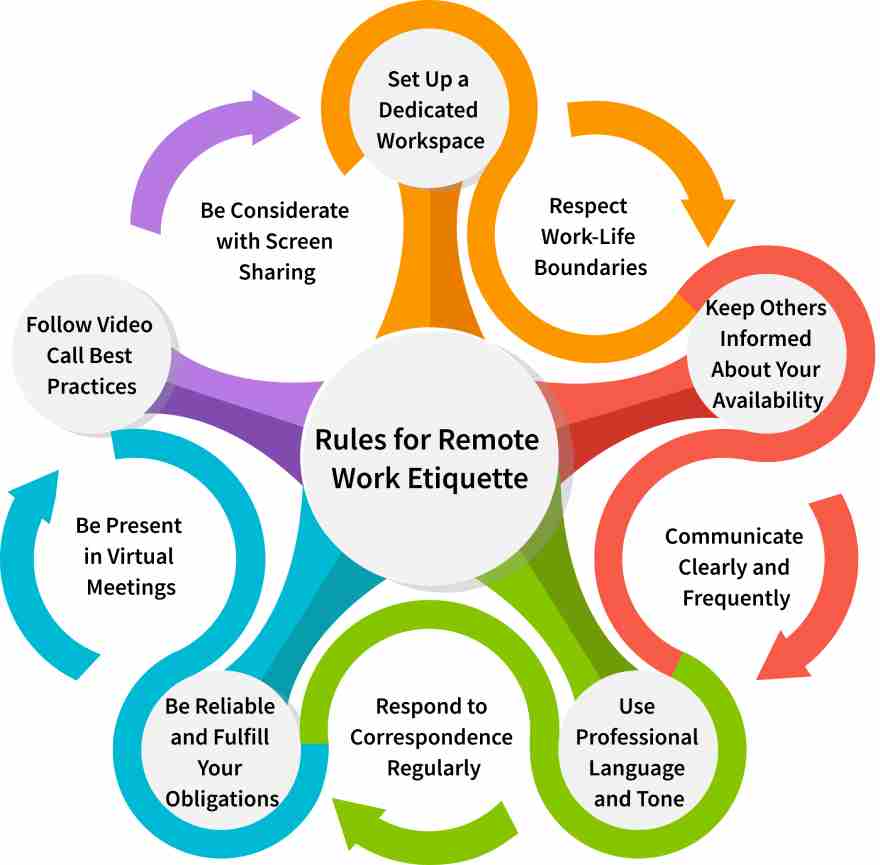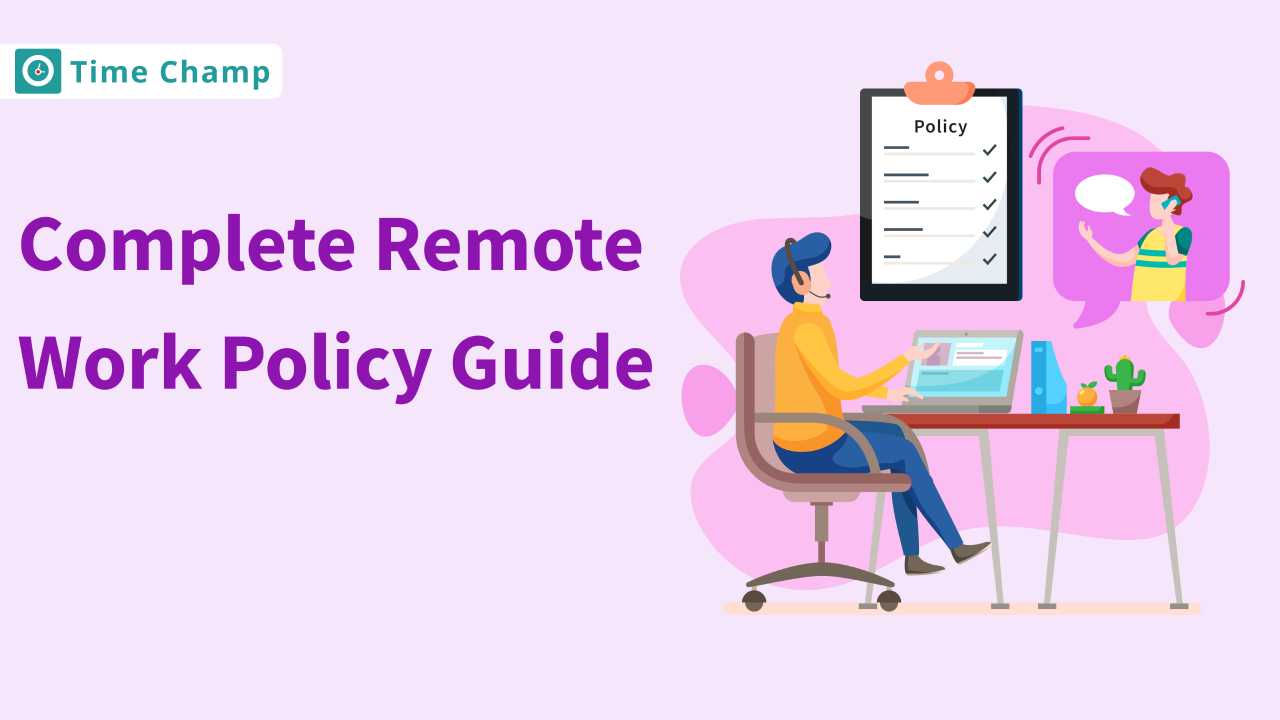Remotely working has its own code of unspoken rules, and knowing these rules makes your job so much easier. Whether it is organizing a workspace or keeping in touch with the rest of your team, remote work etiquette helps you cope with the challenges of working outside a traditional office. By following the important rules of remote work etiquette, you’ll be better at getting things done, working well with others, and staying professional no matter where you’re working from. Let’s go over some key rules that will help you succeed in your remote work setup.
First, let’s take a closer look at what remote work etiquette really means and why it is important for your success in a virtual workspace.
What is Remote Work Etiquette?
Remote work etiquette is all about how you should act while working from home or anywhere else outside the office. It means being professional, respectful, and clear in your communication. So, try to be punctual for virtual meetings, reply to messages promptly, and dress appropriately for video calls. Also, it’s a good idea to minimize distractions during work hours. Do not forget to maintain the work-life balance. Be available when you agree or are expected during working hours, and make sure you finish your tasks.
Why is Remote Work Etiquette Important?
Remote work etiquette is essential as it assists create a good and productive workspace, even when you’re not in the same place. When you respect each other’s time and space, it makes working together easier and improves team spirit. Simple things such as punctuality in meetings and quicker replies to messages show that you care about your colleagues and help everyone feel connected, even if you’re not physically there. By practicing the best remote work etiquette, you not only make a strong impression but also help form a supportive remote team culture, making remote work enjoyable for everyone.
Top Rules for Remote Work Etiquette

Here are the key rules for remote work etiquette to boost productivity and develop teamwork.
1. Set Up a Dedicated Workspace:
Creating a dedicated workspace is essential for staying focused and productive while working from home. This should be a specific place in your house where you don’t get any distractions, so choose a quiet, comfortable spot that includes everything you might need such as a computer, office supplies, and a good chair.
This workspace clearly separates your work time from your personal time, making it easier to get into work mode by the time you sit down and relax once you’re done. You can add personal touches, but it has to be clean since any mess confuses you. Additionally, make sure you have good lighting and great furniture to improve your comfort and focus while working.
2. Respect Work-Life Boundaries:
Establishing clear work-life boundaries avoids burnout and helps you maintain a healthy work-life balance. First, set the working hours. These should correspond with your team and should always be clearly communicated to your team members. Respect these boundaries by committing to disconnect from work outside of your designated hours.
This entails not reading emails or replying to messages pertaining to the company when on personal time. You would be able to recharge and fully engage in your personal activities, while also demonstrating healthy habits for your peers to follow. Once every member of the team respects these boundaries, a work culture is created that values productivity and personal well-being equally well.
3. Keep Others Informed About Your Availability
Informing your workmates about your availability can really make teamwork much better and minimize misunderstandings. Use shared calendars to show your working hours, meetings, and personal engagements you need to attend. If you are busy or can’t talk, you can also update your status on communication platforms.
This openness helps teammates know how long it will take to receive a response from you. It assists in building trust while working together and allows everyone to manage their expectations for response times, and know how to better support one another.
4. Communicate Clearly and Frequently
Effective communication is what makes a remote work arrangement successful. Keep your messages short and crisp and avoid using complicated language. Keep them concise using bullet points or lists to emphasize important details.
Meetings on a regular basis should be scheduled, either through formal meetings or informal conversations, so that the team members are aware of what their counterparts are doing on a project. Regular communication allows for no misunderstandings as well as builds and strengthens relationships in the team. Lastly, encourage feedback and questions to create a team-friendly atmosphere.
5. Use Professional Language and Tone
All interactions at work need to be professional, even in remote working. This means proper use of grammar and respectful communication within emails, chats on instant messaging apps, video conferencing, etc. Formal communication should not overdo informal expressions with slang and emojis. Even when discussing sensitive topics or constructive criticism, decide your words effectively so that the message gets delivered well and in great receptivity.
This not only reflects one’s commitment to the role but also to the colleagues, and it builds a respectful culture in the workplace. Showing professionalism in all your forms of communication will not only enhance your image among the team members but also make them try to hold themselves up in the same manner, thus creating a more respectful and productive work environment.
6. Respond to Correspondence Regularly
Checking the inbox and responding to emails and messages promptly keeps the projects moving and gives an impression of being really interested in the team. You can establish a routine on checking your inbox and be sure that you prioritize those which require urgent attention.
If you need more time before making an effective and comprehensive response, you should acknowledge receipt and also put a timeframe for when you will answer. This practice also shows that you respect the time of others while helping to keep the communication flowing. You can quite easily manage this by setting aside certain hours of the day for work on those emails, thus ensuring you stay responsive to others without compromising your productivity on other things.
7. Be Reliable and Fulfill Your Obligations
Being reliable is crucial to the success of remote work and plays a big role in team dynamics. Agree to do a task or meet a deadline, and deliver on it on time. If there arise problems you could not have foreseen, let your team know quickly so that together you can find a way to correct the problem.
Dependability builds trust and strengthens teamwork. Project management tools have been applied to manage tasks, deadlines, and progress and thus retain the reliability of staying well-organized and responsible. When everybody is reliable, it makes the team work more efficiently and smoothly, which ultimately benefits the whole organization.
8. Be Present in Virtual Meetings
Participating as an active member in virtual meetings showcases that you are attentive and value your colleagues’ time and efforts. This means you should make sure to join at the right time and also that you should come equipped with the necessary information or materials.
Once you have the camera on, it becomes like an actual meeting because it’s closer and personal. Add value to the meeting by raising questions, sharing your thoughts, or listening to others. It makes you more visible in the team and engages each participant fully. Good meeting manners such as muting yourself while you are not talking help keep the meeting focused and productive.
9. Follow Video Call Best Practices
Video call best practices ensure that virtual meetings are conducted with effectiveness. Before the meeting, test your technology to ensure that no technical glitches will occur in the middle of the call. Select a quiet well-lit space for calls beforehand and keep the background clean, professional, and free from distractions.
Wearing appropriate clothes to have a call, just as you would for an in-person meeting, helps maintain a professional atmosphere setting the tone for the call. Be careful of your body language and facial expressions during the meeting as they describe the degree to which you are attentive. It is from such practices that not only will your meetings improve in quality but also reflect upon your level of professionalism and respect for your colleagues.
10. Be Considerate with Screen Sharing
While screen-sharing during virtual meetings, prepare what you would display and close unnecessary tabs and applications on your computer so you can maintain your personal information and avoid distractions from external programs. Explain to colleagues in the chat what you are showing for them to be able to focus on the content being presented.
This helps in setting up an environment where everybody can follow along and then join in. In addition, be mindful of how long you are sharing your screen. Keep your presentation focused and relevant for the respect of others’ time. The carefulness of sharing your screen while holding meetings, for example, will make the meetings more effective while keeping your team members as active participants in this type of situation.
Conclusion
Mastering the rules for remote work etiquette is indispensable for success in a virtual environment. Some of the main rules include setting up a dedicated workspace, separating work-life boundaries, and proper communication with your team to set up a productive atmosphere and create strong relationships. Engage in virtual meetings and be prompt in responding to messages. Always present yourself professionally in all interactions you make. By adopting these practices into your remote work policy and remote work guidelines, you’ll be a dependable colleague and remote mode will work just as well for your company as if all the members were working in a traditional office. Just remember these tips and enjoy the full benefits of remote work!
Frequently Asked Questions
Remote work etiquette makes any virtual workplace more productive and pleasant. It actually encourages teamwork, respect, and good communication, which makes it easier for teams to work together while maintaining a level of professionalism, although they are not physically in the same location.
The proper use of grammar, polite language, and tone helps create a culture of respect in professional communication. It will always ensure that your messages are conveyed clearly, constructively, and positively across any sensitive or challenging situation.
Check your mailbox regularly and respond with no delay to essential messages. However, if you need some time to respond, acknowledge receipt and give a time frame when you will reply to the message. This actually shows respect for your colleagues time, as it helps keep projects moving smoothly.
Prepare your screen before sharing it with the participants; close the unnecessary tabs, and clearly explain to others what you are showing. Keep your presentation on point and concise enough to respect time being spent with others and keep them interested in the meeting.
Be punctual, actively engage by questioning or sharing the ideas, and have all the information ready for the meeting. Be sure to mute the microphone when you’re not talking and make sure that your camera is on for a more personal connection.







